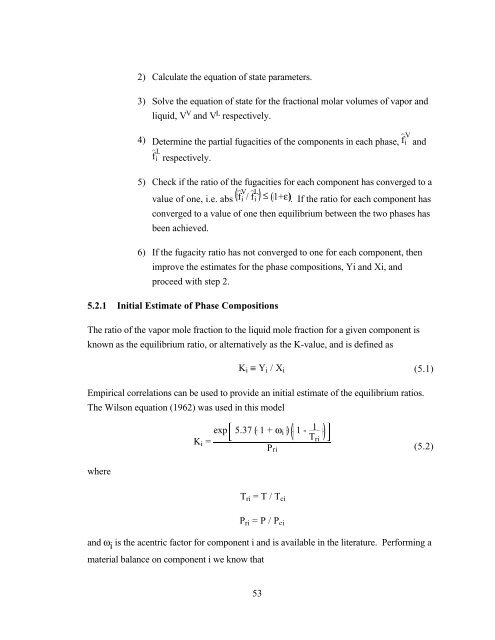multivariate production systems optimization - Stanford University
multivariate production systems optimization - Stanford University
multivariate production systems optimization - Stanford University
Create successful ePaper yourself
Turn your PDF publications into a flip-book with our unique Google optimized e-Paper software.
2) Calculate the equation of state parameters.<br />
3) Solve the equation of state for the fractional molar volumes of vapor and<br />
liquid, VV and VL respectively.<br />
4) Determine the partial fugacities of the components in each phase, fi V and<br />
fi L respectively.<br />
5) Check if the ratio of the fugacities for each component has converged to a<br />
value of one, i.e. abs fi V / fi L<br />
≤ 1+ε . If the ratio for each component has<br />
converged to a value of one then equilibrium between the two phases has<br />
been achieved.<br />
6) If the fugacity ratio has not converged to one for each component, then<br />
improve the estimates for the phase compositions, Yi and Xi, and<br />
proceed with step 2.<br />
5.2.1 Initial Estimate of Phase Compositions<br />
The ratio of the vapor mole fraction to the liquid mole fraction for a given component is<br />
known as the equilibrium ratio, or alternatively as the K-value, and is defined as<br />
Ki ≡ Yi / Xi<br />
Empirical correlations can be used to provide an initial estimate of the equilibrium ratios.<br />
The Wilson equation (1962) was used in this model<br />
where<br />
Ki =<br />
exp 5.37 1 + ωi 1 - 1<br />
Tri<br />
Pri<br />
Tri = T / Tci<br />
Pri = P / Pci<br />
53<br />
(5.1)<br />
(5.2)<br />
and ω i is the acentric factor for component i and is available in the literature. Performing a<br />
material balance on component i we know that

















